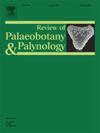泥盆纪晚期南方高纬度地区的古蝶形花树
IF 1.7
3区 地球科学
Q2 PALEONTOLOGY
引用次数: 0
摘要
在泥盆纪时期,植物首次长成森林,对岩石的化学风化、河流系统、大气成分以及可能的水生富营养化产生了影响。假设这些因素导致气候越来越不稳定,最终导致泥盆纪末大灭绝事件的发生。然而,了解森林扩散的时间是与所提出的后果相关联的先决条件。虽然低古纬度地区的森林证据表明它们在泥盆纪中期就已经出现,但稀少的高古纬度记录几乎完全是草本番石榴植物。到了法门纪,森林生态系统在低古纬度地区得到了广泛的证明,但是高纬度地区的古植物几乎只有一个地点,即南非的滑铁卢农场(Waterloo Farm lagerstätte)(近似古纬度,南纬 70 度)。了解该地点的气候和生态条件具有双重重要意义,因为这里也有多种脊椎动物类群,包括唯一的高纬度泥盆纪四足动物。泥盆纪晚期最典型的木本树种--古蝶形花(Archaeopteris)以前曾根据叶枝系统碎片在该地点被确认过,但这些碎片是否代表树形生物仍存在一些不确定性。在这里,我们展示了共同出现的大轴(包括树干基部),可归因于推断高度超过 20 米的古蝶形树,这是泥盆纪高纬度地区森林身材的首次展示。这可能反映了随着伊阿佩托斯海的逐渐关闭,暖洋流向南环流所导致的高纬度气候改善。因此,大陆结构的变化可能间接促进了森林生态系统的扩散,并有助于推动气候的不稳定性,最终导致泥盆纪末期的物种灭绝。本文章由计算机程序翻译,如有差异,请以英文原文为准。
Archaeopteris trees at high southern latitudes in the late Devonian
During the Devonian Period plants first reached forest stature, impacting chemical weathering of rocks, fluvial systems, atmospheric composition and possibly aquatic eutrophication. Hypothetically these factors contributed to increasing climatic instability culminating in the End Devonian Mass Extinction Event. Understanding the timing of the spread of forests is however a prerequisite to correlation with its proposed consequences. Though evidence for forests at low palaeolatitudes demonstrates their emergence by the mid Devonian, sparse high-palaeolatitude records almost entirely comprise herbaceous lycopods. By the Famennian forest ecosystems are widely evidenced at low palaeolatitudes, however high latitude palaeofloras are almost exclusively represented by a single locality, the Waterloo Farm lagerstätte from South Africa (approximate palaeolatitude, 70°S). Understanding climatic and ecological conditions at this locality is doubly important as it also hosts diverse vertebrate taxa, including the only high latitude Devonian tetrapods. Archaeopteris, the quintessential Late Devonian woody tree, has previously been identified at this locality on the basis of leafy branch system fragments, though some uncertainty has remained as to whether these represent tree sized organisms. Here we present co-occurring large axes, including a trunk base, attributable to Archaeopteris trees inferred to be in excess of 20 m height, the first demonstration of forest stature at high latitudes in the Devonian. This possibly reflects high latitude climatic amelioration, resultant from warm ocean currents circulating southwards in response to progressive closure of the Iapetus Sea. As such, changing continental configurations may have indirectly facilitated the spread of forest ecosystems and helped to drive climatic instability and ultimately extinctions towards the end of the Devonian.
求助全文
通过发布文献求助,成功后即可免费获取论文全文。
去求助
来源期刊
CiteScore
3.50
自引率
21.10%
发文量
149
审稿时长
6 months
期刊介绍:
The Review of Palaeobotany and Palynology is an international journal for articles in all fields of palaeobotany and palynology dealing with all groups, ranging from marine palynomorphs to higher land plants. Original contributions and comprehensive review papers should appeal to an international audience. Typical topics include but are not restricted to systematics, evolution, palaeobiology, palaeoecology, biostratigraphy, biochronology, palaeoclimatology, paleogeography, taphonomy, palaeoenvironmental reconstructions, vegetation history, and practical applications of palaeobotany and palynology, e.g. in coal and petroleum geology and archaeology. The journal especially encourages the publication of articles in which palaeobotany and palynology are applied for solving fundamental geological and biological problems as well as innovative and interdisciplinary approaches.

 求助内容:
求助内容: 应助结果提醒方式:
应助结果提醒方式:


